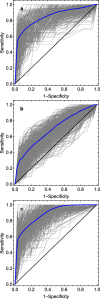Validation of prediction models of severe disease course and non-achievement of remission in juvenile idiopathic arthritis: part 1-results of the Canadian model in the Nordic cohort
- PMID: 31806043
- PMCID: PMC6896283
- DOI: 10.1186/s13075-019-2060-2
Validation of prediction models of severe disease course and non-achievement of remission in juvenile idiopathic arthritis: part 1-results of the Canadian model in the Nordic cohort
Abstract
Background: Models to predict disease course and long-term outcome based on clinical characteristics at disease onset may guide early treatment strategies in juvenile idiopathic arthritis (JIA). Before a prediction model can be recommended for use in clinical practice, it needs to be validated in a different cohort than the one used for building the model. The aim of the current study was to validate the predictive performance of the Canadian prediction model developed by Guzman et al. and the Nordic model derived from Rypdal et al. to predict severe disease course and non-achievement of remission in Nordic patients with JIA.
Methods: The Canadian and Nordic multivariable logistic regression models were evaluated in the Nordic JIA cohort for prediction of non-achievement of remission, and the data-driven outcome denoted severe disease course. A total of 440 patients in the Nordic cohort with a baseline visit and an 8-year visit were included. The Canadian prediction model was first externally validated exactly as published. Both the Nordic and Canadian models were subsequently evaluated with repeated fine-tuning of model coefficients in training sets and testing in disjoint validation sets. The predictive performances of the models were assessed with receiver operating characteristic curves and C-indices. A model with a C-index above 0.7 was considered useful for clinical prediction.
Results: The Canadian prediction model had excellent predictive ability and was comparable in performance to the Nordic model in predicting severe disease course in the Nordic JIA cohort. The Canadian model yielded a C-index of 0.85 (IQR 0.83-0.87) for prediction of severe disease course and a C-index of 0.66 (0.63-0.68) for prediction of non-achievement of remission when applied directly. The median C-indices after fine-tuning were 0.85 (0.80-0.89) and 0.69 (0.65-0.73), respectively. Internal validation of the Nordic model for prediction of severe disease course resulted in a median C-index of 0.90 (0.86-0.92).
Conclusions: External validation of the Canadian model and internal validation of the Nordic model with severe disease course as outcome confirm their predictive abilities. Our findings suggest that predicting long-term remission is more challenging than predicting severe disease course.
Keywords: Juvenile idiopathic arthritis; Outcome research; Prediction; Remission; Validation.
Conflict of interest statement
The authors declare that they have no competing interests.
Figures


References
-
- Petty RE, Southwood TR, Manners P, Baum J, Glass DN, Goldenberg J, He X, Maldonado-Cocco J, Orozco-Alcala J, Prieur AM, et al. International League of Associations for Rheumatology classification of juvenile idiopathic arthritis: second revision, Edmonton, 2001. JRheumatol. 2004;31(2):390–392. - PubMed
-
- Moons KG, Altman DG, Reitsma JB, Ioannidis JP, Macaskill P, Steyerberg EW, Vickers AJ, Ransohoff DF, Collins GS. Transparent Reporting of a multivariable prediction model for Individual Prognosis or Diagnosis (TRIPOD): explanation and elaboration. Ann Intern Med. 2015;162(1):W1–73. doi: 10.7326/M14-0698. - DOI - PubMed
Publication types
MeSH terms
Substances
LinkOut - more resources
Full Text Sources
Medical

